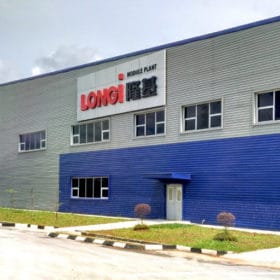
The exercise, conducted on Longi PERC bifacial modules by Germany’s TÜV SÜD at a test field in China, showed surprisingly higher gains in panels getting light reflection from painted-surface and grassland albedo. It also showed, Longi claimed, bifacial panels operate at lower temperatures than single-sided alternatives.
Chinese module manufacturer Longi Solar has published the results of a test conducted on its PERC bifacial modules by German testing and product certification services provider TÜV SÜD.
Longi said the modules were tested at a pilot solar plant in Ding’an county on the island province Hainan, China’s southernmost territory. The manufacturer said data was collected on module yields under different surface reflection conditions from September 2018 to April.

Image: Longi Solar
The company said the location has annual solar irradiance of 1,668.4 kWh/kWp/m² and an annual average temperature of around 24 degrees Celsius. Longi added, the solar modules were positioned with similar shading conditions, at heights of 1-1.5m. The manufacturer installed an irradiator on the steel of the front module to record the irradiance of oblique incidence and the accuracy of the irradiance, and two irradiators at the top and bottom of the rear module to record the irradiance reflected from the rear side. Thermocouples were also used at the middle and edge of the rear module of each array to test operating temperature.
Surprising albedo results
Longi said it tested the modules with different albedo including white paint with a reflectance of 67.21%, cement (43.1%), sandy soil (40.46%) and grassland (16.1%).
The energy yields of bifacial PERC modules grew significantly when placed at 1.5m, with gains of 10.1% on grassland, 15.82% on sand, 14.5% on cement and 20.59% on white painted surfaces, compared with single-sided PERC modules tested in the same conditions. Those results, Longi claimed, were in line with a trend that the higher the surface reflectance, the higher the energy gain. “The energy gain is as high as 20.59% on the white painted surface with a reflectivity of 67.21%, and 10.1% on the grassland, which is higher than [the] expected value,” the manufacturer stated.
The Chinese company said additional gains provided by bifacial technology in the region are higher in summer due to the longer duration of mornings and evenings and periodic variation of the solar elevation angle. “The energy gain in January and February of 2019 is over 5% lower than that in other months, which [is] mainly caused by the change of the solar elevation angle,” Longi said.
Lower temperatures
The manufacturer also tested the operating temperature of bifacial and single-sided panels using rear-side sensors. Bifacial products operated under lower temperatures due to the lower thermal effect produced by higher infrared radiation. The company also attributed the result to the use of 2mm+2mm glass which, in its view, has a better heat dissipation speed than that of 3.2mm glass-backsheet panels.
“In summary, the TÜV SÜD Hainan pilot project fully verified the excellent power generation performance of the Longi Hi-MO PERC bifacial modules, and specifically verified the effects of reflectance, installation height and scattered light ratio on the bifacial energy gain,” the company said.
Longi launched the Hi-MO 4 module in May, claiming efficiencies of 18.5-19.2% and a power rating of up to 430 watts.
Lắp đặt điện mặt trời Khải Minh Tech
https://ift.tt/2X7bF6x
0906633505
info.khaiminhtech@gmail.com
80/39 Trần Quang Diệu, Phường 14, Quận 3
Lắp đặt điện mặt trời Khải Minh Tech
https://ift.tt/2ZH4TRU
Không có nhận xét nào:
Đăng nhận xét